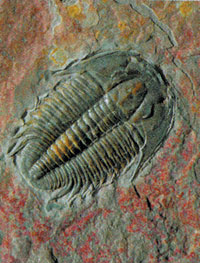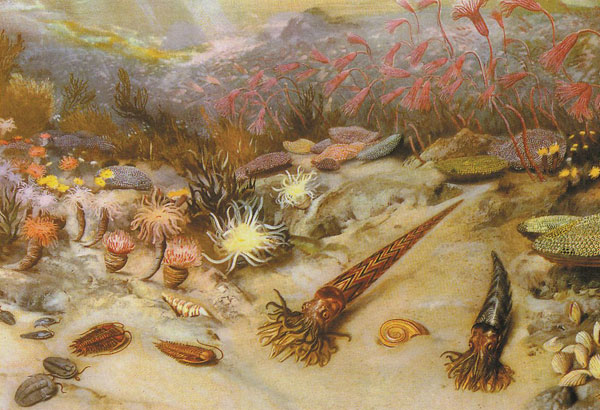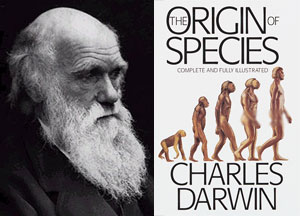A trilobite fossil
13. How Do The Complex Structures Of The Most Ancient Creatures Demolish The Theory Of Evolution?
Living things form a chain in the fossil record. When we look at these from the oldest to the more recent, they emerge in the form of micro organisms, invertebrate sea creatures, fish, amphibians, reptiles, birds, and mammals. Proponents of the theory of evolution describe this chain in a prejudiced manner, and try to present it as proof of the theory of evolution. They claim that living things developed from simple to complex forms, and that during this process a wide variety in living species came about. For example, evolutionists suggest that the fact that no human fossils are to be found when 300-million-year-old fossil beds are examined is in some way proof of this. The Turkish evolutionist Professor Aykut Kence says:
Do you wish to invalidate the theory of evolution? Then go and find some human fossils from the Cambrian Age! Anyone who does that will disprove the theory of evolution, and even win the Nobel Prize for his discovery.56
Development from the primitive to the complex is an imaginary concept
 |
Let us examine the evolutionist logic that pervades Professor Kence's words. The statement that living things developed from primitive forms to complex ones is an evolutionist prejudice that in no way reflects the truth. The American professor of biology Frank L. Marsh, who considered that evolutionist claim, maintains in his book Variation and Fixity in Nature, that living things cannot be arranged in a continuous, unbroken series from simple to complex.57
The fact that almost all known animal phyla suddenly emerged in the Cambrian period is strong evidence against evolutionist claims in this regard. Furthermore, those creatures which suddenly emerged possessed complex bodily structures, not simple ones—the exact opposite of the evolutionist assumption.
Trilobites belonged to the Arthropoda phylum, and were very complicated creatures with hard shells, articulated bodies, and complex organs. The fossil record has made it possible to carry out very detailed studies of trilobites' eyes. The trilobite eye is made up of hundreds of tiny facets, and each one of these contains two lens layers. This eye structure is a real wonder of design. David Raup, a professor of geology at Harvard, Rochester, and Chicago Universities, says, "the trilobites 450 million years ago used an optimal design which would require a well trained and imaginative optical engineer to develop today."58

In Darwin's time, the Cambrian Age was included in the Silurian Age, and Darwin remained silent in the face of the complex structures of the living things that suddenly emerged at that time. In the succeeding 150 years, Darwinism's dilemma on this matter has grown even greater. Above: The Silurian Age by Zdenek Burian.
Another interesting aspect of the matter is that flies in our day possess the same eye structure. In other words, the same structure has existed for the last 520 million years.
Very little was known about this extraordinary situation in the Cambrian Age when Charles Darwin was writing The Origin of Species. Only since Darwin's time has the fossil record revealed that life suddenly emerged in the Cambrian Age, and that trilobites and other invertebrates came into being all at once. For this reason, Darwin was unable to treat the subject fully in the book. But he did touch on the subject under the heading "On the sudden appearance of groups of allied species in the lowest known fossiliferous strata," where he wrote the following about the Silurian Age (a name which at that time encompassed what we now call the Cambrian):
For instance, I cannot doubt that all the Silurian trilobites have descended from some one crustacean, which must have lived long before the Silurian age, and which probably differed greatly from any known animal… Consequently, if my theory be true, it is indisputable that before the lowest Silurian stratum was deposited, long periods elapsed, as long as, or probably far longer than, the whole interval from the Silurian age to the present day; and that during these vast, yet quite unknown, periods of time, the world swarmed with living creatures. To the question why we do not find records of these vast primordial periods, I can give no satisfactory answer.59
 Charles Darwin The Origin of Species |
Darwin said "If my theory be true, it is indisputable that the world swarmed with living creatures before the Silurian Age." As for the question of why there were no fossils of these creatures, he tried to supply an answer throughout his book, using the excuse that "the fossil record is very lacking." But nowadays the fossil record is quite complete, and it clearly reveals that creatures from the Cambrian Age did not have ancestors. This means that we have to reject that sentence of Darwin's which begins "If my theory be true." Darwin's hypotheses were invalid, and for that reason, his theory is mistaken.
Another example demonstrating that life did not develop from primitive forms to complex ones and that life was already exceedingly complex from the moment when it first emerged is the shark, which the fossil record shows to have emerged some 400 million years ago. This animal possesses superior features not even seen in animals created millions of years after it, such as the way it can regenerate lost teeth. Another example is the astonishing resemblances between mammals' eyes and those of octopuses which lived on Earth millions of years before mammals.
 The number of chromosomes is not directly related to the complex structures of living things. This is a fact that invalidates the claims of the theory of evolution. |
These examples make it clear that living species cannot be neatly arranged from the primitive to the complex.
This fact also emerged as the result of analyses of studies of living things' forms, functions, and genes. For instance, when we examine the very lowest levels of the fossil record from the point of view of shape and size, we see many creatures that were much larger than those which came later (such as dinosaurs).
When we look at the functional properties of living things, we see exactly the same thing. As regards structural development, the ear is an example that disproves the claim of "development from the primitive to the complex." Amphibians possess a middle-ear space, yet reptiles, which emerged after them, have a much simpler system, based on a single small bone, and have no middle-ear space at all.
Genetic studies have produced similar results. Research has demonstrated that the number of chromosomes has no relation to animals' complexity. For example, human beings possess 46 chromosomes, the copepode six, and the microscopic creature called radiolaria exactly 800.
Living things were created at the most "appropriate" time for them
The real fact that emerges from examination of the fossil record is that living things emerged in the periods most suitable for them. God has designed all creatures superbly, and has made them well-suited to meet their needs at the times when they emerged on the Earth.
Let us consider one example of this: the Earth at the time when the oldest bacteria fossils emerge, some 3.5 billion years ago. Atmospheric and temperature conditions at the time were not at all suited to support complex creatures or human beings. That also applies to the Cambrian Age, the finding of human fossils from which, according to the evolutionist Kence, would invalidate the theory of evolution. This period, which refers to some 530 million years ago, was definitely unsuitable for human life. (There were no land animals at all at that time.)
The situation is the same in the great majority of succeeding periods. Examination of the fossil record shows that conditions able to support human life have only existed for the last few million years. The same applies to all other living things. Each living group emerged when the appropriate conditions for it had been arrived at—in other words, "when the time was right."
Evolutionists make an enormous contradiction in the face of that fact, trying to explain it as if these appropriate conditions themselves had created living things, whereas the coming about of "appropriate conditions" only meant that the right time had come. Living things can only emerge with a conscious intervention—in other words, a supernatural creation.
For this reason, the emergence of living things by stages is evidence not of evolution, but of the infinite knowledge and wisdom of God, Who created them. Every living group created established the appropriate conditions for the next group to emerge, and an ecological balance with all living things was set up for us over a long period of time.
On the other hand, we must be aware that this long period of time is only long to us. For God it is but a single "moment." Time is a concept that only applies to created things. As the creator of time itself, God is not bound by it. (For more details see Harun Yahya: Timelessness and the Reality of Fate.)
If evolutionists wish to show that one species turned into another, then showing that living things emerged step by step on the Earth is no good. The evidence they have to come up with is fossils of the intermediate forms that link these different species together. A theory that maintains that invertebrates turned into fish, fish into reptiles, and reptiles into birds and mammals has to find the fossils to prove it. Darwin accepted that, and wrote that countless examples of these would have to be found, even though none were so far available. In the 150 years that have passed since then, no intermediate forms have been found. As the evolutionist paleontologist Derek W. Ager has admitted, the fossil record shows "not gradual evolution, but the sudden explosion of one group at the expense of another."60
In conclusion, natural history reveals that living things did not come about by chance, but that they were created, stage by stage, over long periods over time. This is in complete agreement with the information about creation given in the Qur'an, in which God reveals that he created the universe and all living things in "six days":
The word "day" in the verse (yawm in Arabic) also means a long period of time. In other words, the Qur'an notes that all of nature was created over different times, not all at once. Modern geological discoveries paint a picture that confirms this.
Footnotes
56. Evrim Kuramı Konferansı (Conference on the Theory of Evolution), Istanbul Universitesi Fen Fakultesi (University of Istanbul, Facul†y of Science), June 3, 1998
57.http://www.icr.org/creationproducts/creationscienceproducts/Variation_and_Fixity_in_Nature.html (emphasis added)
58. David Raup, "Conflicts Between Darwin and Paleontology,” Bulletin, Field Museum of Natural History, vol. 50, January 1979, p. 24
59. Charles Darwin, The Origin of Species, 1859, p. 313-314, (emphasis added)
60. Derek A. Ager, "The Nature of the Fossil Record,” Proceedings of the British Geological Association, vol 87, 1976, p. 133, (emphasis added)
- Introduction
- 2. How does the collapse of the theory of evolution demonstrate the truth of creation?
- 1. Why ıs the theory of evolution not scientifically valid?
- 3. How far back do traces of man go? Why do these not support evolution?
- 4. Why ıs the theory of evolution ''not the basis of biology''?
- 5. Why is the existence of different races not evidence for evolution?
- 6. Why is the claim that human and ape genomes are 99 percent similar and that this confirms evolution not true?
- 7. Why is the claim that dinosaurs evolved ınto birds an unscientific myth?
- 8. What scientific forgery ıs the myth that ''human embryos have gills'' based on?
- 9. Why is ıt deceptive to portray cloning as ''evidence for evolution''?
- 10. Could life have come from outer space?
- 11. Why does the fact that the earth is four billion years old not support the theory of evolution?
- 12. Why are wisdom teeth not evidence of evolution?
- 13. How do the complex structures of the most ancient creatures demolish the theory of evolution?
- 14. Why is denying the theory of evolution portrayed as rejecting development and progress?
- 15. Why is ıt mistaken to think that God could have created living things by evolution?
- 16. Why is it wrong to think that evolution could be confirmed ın the future?
- 17. Why is metamorphosis not evidence of evolution?
- 18. Why is it impossible to account for dna by ''chance''?
- 19. Why is it that bacterial resistance to antibiotics is not an example of evolution?
- 20. What kind of relationship is there between creation and science?
